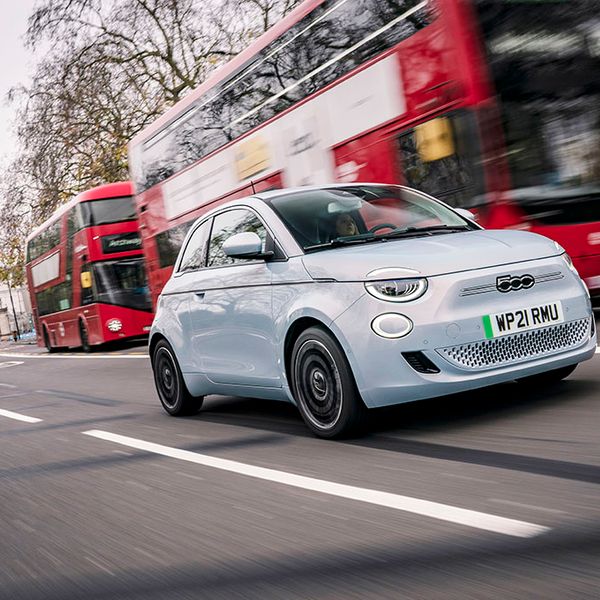Testing times - how do MoT tests work for electric cars?
The annual MoT test is a chore for every motorist. And if you have an electric vehicle, you will still need to have it tested in the same way every year after the car’s third birthday. But the good news is that the test is less complicated than for a petrol or diesel and you are more likely to pass too, according to the official data.
To make the MoT less testing, we’ve got together with the experts at Green Flag to produce this handy guide to making sure your electric car gets that all-important certificate and stays legal.
![Grey 2015 Nissan Leaf in MoT test bay on ramps]() Electric vehicles have to be tested annually once they reach three years old, like any other car
Electric vehicles have to be tested annually once they reach three years old, like any other car How different is an MOT test for an electric vehicle?
There’s not a huge difference in the test of an electric car and any other vehicle. When you arrive the tester will enter the registration number of your car into a computer, and it will generate a check list of what needs to be tested according to the age and fuel type of the car. This means they don’t have to check in a book or do any research online – the information is all generated for them.
Many parts of an electric car’s test will be the same as with any other vehicle. That means the tyres, brake operation and wear, lights, seatbelts and so on will be tested. They will also check the windscreen for chips and cracks and look for bodywork damage which could be dangerous.
The mechanic will then raise your car on a ramp to inspect the vehicle from underneath, looking for structural damage. On older cars this will include rust, but this is unlikely to affect a modern electric car yet unless they have been poorly repaired after an accident.
They will also check the suspension and steering, jacking up the car so the wheels are off the ground to check for slack in the components or worn bushes and gaiters.
After that, the tester will find life slightly easier as there is no fuel system, exhaust or oil leaks to check on an electric car. They’ll also be able to skip the emissions part of the test too.
![Grey 2015 Nissan Leaf in MoT test bay on ramps, with tester checking data on computer screen]() The car will be placed on a ramp and the tester will run through the check list
The car will be placed on a ramp and the tester will run through the check list And how long will my electric car’s MoT test take?
An average MoT test will take between 45 minutes and an hour, but as an electric car has fewer items to check it will be around 15 minutes quicker than normal. This may make the tester happy as they get paid the same but will be able to squeeze in a tea break. You might be able to get back on the road faster too.
Do all garages do MoT tests on electric cars?
Every garage which is licenced to carry out MoTs should be happy to test an electric car, especially as the test is actually simpler than checking a petrol or diesel. But the garage may warn you that they will not be able to carry out any repairs to the electrical drive system if there is a problem as this requires special training.
The most likely failure points are items such as bulbs, wipers, tyres and brakes and these are just as easy to repair on an electric car as any other.
![Split rear windscreen wiper on a grey 2015 Nissan Leaf]() Windscreen wipers are a common failure point, although a split blade on the rear screen like this won't result in a fail
Windscreen wipers are a common failure point, although a split blade on the rear screen like this won't result in a fail How much will an MoT on an electric car cost me?
The Government caps the price for a car’s MOT test at £54.85 in the UK (correct as of September 2022), and it makes no difference what type of fuel it uses. Most garages, especially independents, may offer a discount on this price though. Some may add further discounts if you have the car serviced at the same time as the test.
Will I need to give the garage any special instructions before they MoT my electric car?
MoT testers will be used to driving thousands of different cars, so should be used to the controls on your vehicle. However, there is no harm in just reminding them how some unusual features work – for example the gear selector and foot-operated parking brake on the first-generation Nissan Leaf has been known to puzzle mechanics in the past. You might also want to change the menus on the instruments so that the mileage is clearly visible – this needs to be entered on the form for the certificate.
![MoT tester entering details into a computer in workshop]() The tester will enter details of the mileage into the computer to be entered into the government's database
The tester will enter details of the mileage into the computer to be entered into the government's database What if I fail?
If your car fails, the mechanic will talk you through the options. A simple fix such as a bulb or wiper blade might be a done within minutes with your approval. More complicated fettling such as new brake pads might need some parts to be ordered in, but this can sometimes happen in the same day.
If there is a bigger repair which might require specialist knowledge, the garage might ask you to find an electric car specialist or main dealer. If your car’s MoT has expired it will be illegal to move it unless it is to a pre-booked test, so it is best to book your MoT before your test is due.
Even if you do this though, you should not drive the car if it has a dangerous fault.If you’ve booked your MoT in advance of the expiry date and you aren’t able to drive it to the appointment due to an unforeseen fault then your breakdown provider may be able to help you, dependant on your coverage terms.
![Grey 2015 Nissan Leaf on MoT brake test rollers in workshop]() If you car fails, the MoT tester will talk you though the options
If you car fails, the MoT tester will talk you though the options Top tips to help your electric car breeze through its MoT test
1. Retyre gracefully – Tyres are one of the biggest failure points for MoTs, and electric cars can wear the rubber more heavily as they carry more weight than a conventional car. Have a good look at the tread and check for bulges, cracks and nicks in the sidewall which could be dangerous. If the tread gaps are below 1.6mm across the centre ¾ of the surface, it will fail. Even if it is marginal, it will be worth changing the tyres as new rubber with more tread will improve safety dramatically in the wet.
If you have any concerns about the tyres it would be better to get it sorted before the test so you have time to shop around, especially if the tyres are an odd size or a specialist fitment.
2. Top of the stops - Regenerative braking allows electric cars to use the electric motor to slow the car down and preserve energy that would otherwise be lost. It also means brake discs and pads wear less, but this in turn can cause its own issues as they can corrode and even seize due to the lack of use. Have a look at the discs and see if they look worn or rusty. Then drive down the road and brake hard when it is safe to do so. Sounds of grinding could suggest an issue, and you should get them looked at by a professional.
![]() Electric cars brakes can corrode as they see little use
Electric cars brakes can corrode as they see little use 3. Clean sweep – You rely on two thin strips of rubber to keep your vision clear in the filthiest weather. And yet we often neglect our wipers and might not even notice they are getting old and worn until they split – usually when you need them most. A dodgy blade will be an MoT failure, but even if they are not split it is worth investing the £20 or so in getting them changed if they are a few years old – you’ll be surprised at the difference.
There are plenty of videos on YouTube showing you how to change them yourself, or a garage will do it for a few quid.
4. Lights fantastic - Checking the lights has always been a key part of the MoT test and it is one of the easiest things to check. You can either recruit an assistant to look at the various bulbs and functions as you operate them from the driver’s seat, or you can park in front of a glass window so you can see the reflection of the car.
Many new cars come with LED lights and sophisticated lamp clusters which are more reliable than old-fashioned bulbs, but they can still fail over time. Also, broken lenses will get a black mark from the tester.
5. Make a date - Planning your test needs a bit of organisation. You can either make a note of when it’s due in your calendar or use the government’s own reminder service to give you plenty of notice. Your garage may also send you a letter or email to help you out and drum up some business.Book it in plenty of time, as test stations can get busy, especially at certain times of year, such as March and September, when there are lots of new cars registered which all need tests at the same time a few years later.
![Grey 2015 Nissan Leaf in MoT test bay on ramps]() Check your lights before the tester does
Check your lights before the tester does Green Flag Breakdown Cover is underwritten by U K Insurance Limited.
 Electric vehicles have to be tested annually once they reach three years old, like any other car
Electric vehicles have to be tested annually once they reach three years old, like any other car 












.jpg?width=600&height=600)



